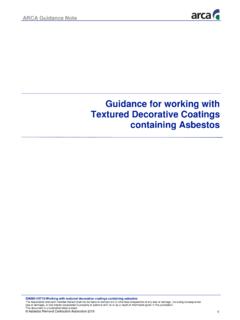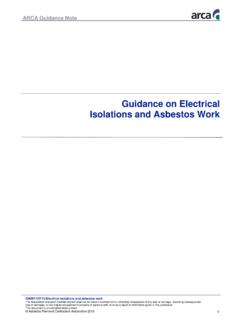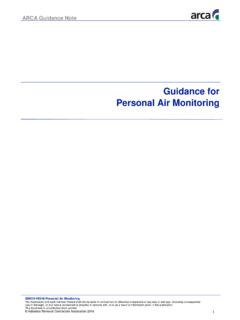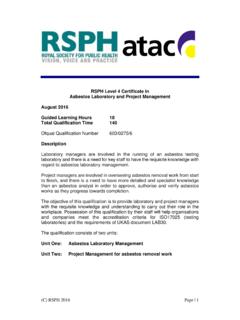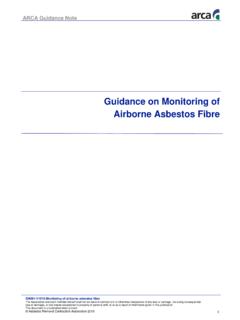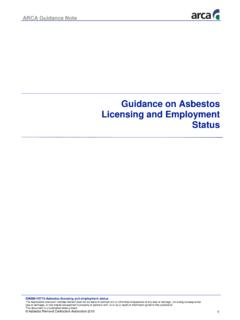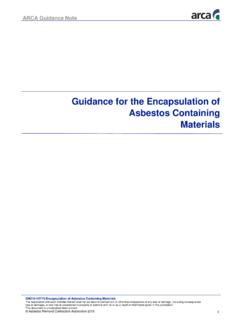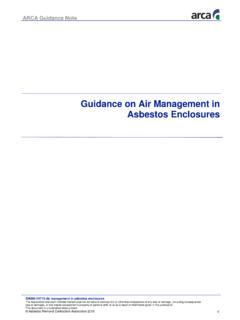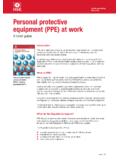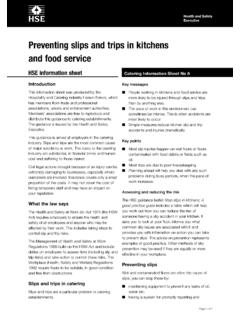Transcription of Guidance on the Selection of Personal Protective …
1 1 GN003-V0615- Selection of Personal Protective equipment for work with asbestos The Association and each member thereof shall not be liable in contract tort or otherwise irrespective of any loss or damage, (including consequential loss or damage), or any nature occasioned to property or persons with, to or as a result of information given in this publication. This document is uncontrolled when printed. Asbestos Removal Contractors Association 2015 ARCA Guidance Note Guidance on the Selection of Personal Protective equipment (PPE) for work with Asbestos 2 GN003-V0615- Selection of Personal Protective equipment for work with asbestos The Association and each member thereof shall not be liable in contract tort or otherwise irrespective of any loss or damage, (including consequential loss or damage), or any nature occasioned to property or persons with, to or as a result of information given in this publication.
2 This document is uncontrolled when printed. Asbestos Removal Contractors Association 2015 ARCA Guidance Note Guidance ON THE Selection OF Personal Protective equipment (PPE) FOR work WITH ASBESTOS 1. OBJECTIVE The purpose of this Guidance note is to identify best practice and provide practical Guidance on Selection , care and maintenance of Personal Protective equipment (PPE) against risks from working with asbestos. This document excludes Respiratory Protective equipment (RPE). 2. DUTY TO SUPPLY Protective CLOTHING When selecting and using Protective clothing for work with asbestos, all employees must ensure that they comply with both the requirements of the Control of Asbestos Regulations 2012 and the Personal Protective equipment at work Regulations 1992 (as amended). In general, these regulations require that Personal Protective equipment (PPE) must be supplied when an employee is exposed to a risk which cannot be controlled by any other means.
3 PPE must be appropriate to the risks and not increase the risk. PPE must fit the wearer. When wearing two or more items of Protective equipment , these items must be compatible. When employees are required to wear PPE they must be trained in its use, care and maintenance. It is a further requirement of the Personal Protective equipment at work Regulations 1992 that the employer shall provide all Protective equipment for use at work , free of any charge. Where staff work under the control of an asbestos licence holder they are considered to be employees, irrespective of how they are paid. Genuinely self-employed persons would be working entirely under their own control and direction; if this is the case those individuals would need their own Personal asbestos licence to undertake the work with asbestos and would be required to notify the work in accordance with standard licence conditions.
4 The HSE has not granted any such individual licences as it is not possible to carry out licensable work with asbestos as an individual working alone. Reference ARCA Guidance Note GN008 on Asbestos Licensing and Employment Status . PPE is required to be 'CE' marked in accordance with the requirements of the amended Personal Protective equipment Regulations 1992. A 'CE' mark signifies that the PPE satisfies certain basic safety requirements and in most cases will have been type tested and certified by an independent body. 3 GN003-V0615- Selection of Personal Protective equipment for work with asbestos The Association and each member thereof shall not be liable in contract tort or otherwise irrespective of any loss or damage, (including consequential loss or damage), or any nature occasioned to property or persons with, to or as a result of information given in this publication.
5 This document is uncontrolled when printed. Asbestos Removal Contractors Association 2015 ARCA Guidance Note All PPE used at work , including clothing for protection against adverse weather, must be certified with the letters CE followed by the Category of Approval. 3. Selection OF COVERALLS FOR work WITH ASBESTOS Managing and working with asbestos Control of Asbestos Regulations 2012 Approved Code of Practice and Guidance L143 requires that the Selection criteria for coveralls for work with asbestos should include the following: they should fit the wearer they should be comfortable they should be one piece including the hood they should allow for the effects of physical strain the cuffs, wrists and hood should be elasticated they should have no pockets they should be easy to decontaminate they should resist penetration by fibres Coveralls for use when working with asbestos meet most of these criteria; however the subjects of durability and fibre penetration continue to be an issue for contractors.
6 Most contractors who work with asbestos use disposable coveralls, both inside the enclosure, and when in transit. Disposable coveralls are not durable but may meet fibre penetration standards. Some types of coverall can add to the problem of heat stress of the wearer. Non-disposable coveralls are more durable but do not meet fibre penetration standards, they also require specialist handling, decontamination and laundering. Additional clothing may be required for work in cold environments, although it should be noted that all clothing worn within an asbestos contaminated area must be laundered at a specialist laundry or disposed of as asbestos waste. 4. DURABILITY The durability of a coverall depends upon three factors: Size - Coveralls often split because they are too small Fabric strength - Disposable coverall fabrics are not robust Seam strength - Seams which are single sewn will pull apart easier.
7 Under stress it will be possible to see daylight through the seam. Seams should be over sewn to provide additional strength 4 GN003-V0615- Selection of Personal Protective equipment for work with asbestos The Association and each member thereof shall not be liable in contract tort or otherwise irrespective of any loss or damage, (including consequential loss or damage), or any nature occasioned to property or persons with, to or as a result of information given in this publication. This document is uncontrolled when printed. Asbestos Removal Contractors Association 2015 ARCA Guidance Note 5. PENETRATION Whilst coveralls reduce the amount of contamination to the operative they do not totally prevent fibre penetration, hence the need for decontamination at the end of each shift.
8 The following CE standards currently apply. Category 1: 'Simple Products' - which are not suitable for protection against any hazard Category 2: 'Intermediate Products' - which fall into neither category 1 or 3 Category 3: Complex products' - which are worn in order to provide protection against any hazard which may be life threatening Coveralls for work with asbestos must meet category 3 standards. Within CE category 3 there are several 'types' of coverall. Type 2 EN 943:1995 - non gas tight suits which retain a positive internal pressure to prevent the ingress of dusts, liquids or vapours Type 5 EN ISO 13982 -1 - Protective clothing for use against solid particulate chemicals Type 6 EN 13034 - reduced spray suits, suitable for protection against hazardous sprays and splashes as fine droplet, non directional sprays When using overalls complying with both types 5 and 6 consideration must be given to determine that they are 'breathable' and that the type 6 property has not compromised their 'breathability'.
9 Many brands of 'type 6' coverall achieve their splash resistance by increasing the "plastic content of the fabric, thus reducing their ventilation ability. Coveralls for work with asbestos both inside enclosures and when transiting should exhibit properties consistent with class 3, type 5, in order to minimise body contamination leading to a more effective decontamination on leaving the enclosure. ARCA recommended Guidance is that transit overalls should be used on a single use basis only. 6. Selection OF UNDERCLOTHES FOR work WITH ASBESTOS Disposable underclothes should be worn to allow for the effects of chilling in low temperatures. This should be disposed of as contaminated waste in a manner similar to the coveralls. 7. Selection OF FOOTWEAR FOR work WITH ASBESTOS The employer should carry out a risk assessment to determine the type of footwear to be used in any given situation.
10 5 GN003-V0615- Selection of Personal Protective equipment for work with asbestos The Association and each member thereof shall not be liable in contract tort or otherwise irrespective of any loss or damage, (including consequential loss or damage), or any nature occasioned to property or persons with, to or as a result of information given in this publication. This document is uncontrolled when printed. Asbestos Removal Contractors Association 2015 ARCA Guidance Note When removing asbestos inside enclosures, steel toe capped wellington boots are preferred, as they can easily be decontaminated. Lace up boots, with the laces taped up, are not recommended. Footwear for transiting between the airlock of the asbestos enclosure and the hygiene unit should be easy to decontaminate. Rubber slip-ons are recommended as the most appropriate based on member's experience; however it must be assessed as to whether they are appropriate for the specific environment or site situation in which they are to be used, taking in to account issues such as work at height or slip hazards, for example.
